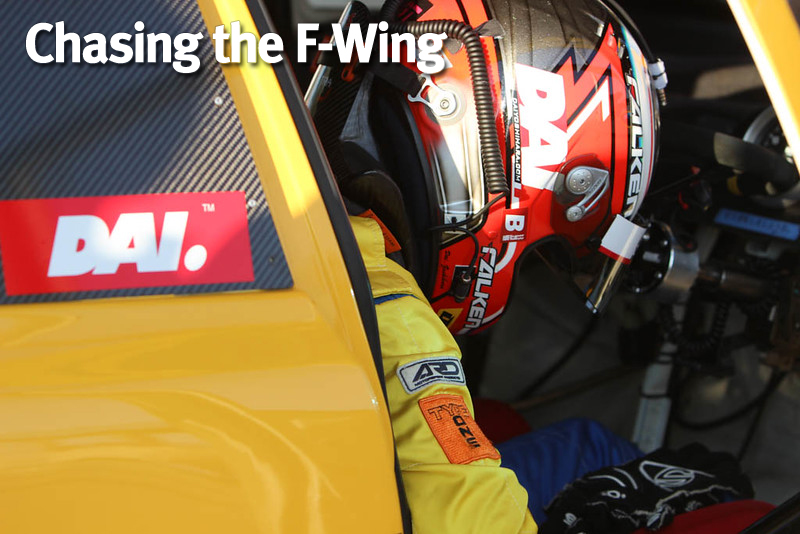
Chasing the F-Wing: How Spoon Sports USA Beat the FWD Unlimited Record
Last week at the annual 2015 GTA Super Lap Battle at Buttonwillow Raceway, Chris Rado's long standing FWD Unlimited Time Attack Record was shattered by Dai Yoshihara driving the Spoon Sports USA Honda Civic to a blistering lap time of 1:45.585 seconds to Rado's 1:46.730 set in 2010.
GTA's Superlap Battle held on Buttonwillow Raceways configuration 13 clockwise has global acceptance as being the lap time record standard for North American time attack. Likewise Rado's five year old record has been the longest standing record in North American Time Attack history, a holy grail that many considered to be unbeatable by anyone other than Rado himself.
The record was set by the Scion Racing F-Wing TC, one of the most radical, expensive and high tech time attack cars ever constructed. With 1200 hp, an innovative drivetrain and ground breaking Aerodynamics, the F-Wing hit speeds thought to be impossible for a FWD car by many and for a time contested for the overall lap record at many venues.
The record has been broken, not by a technological terror super machine but by a team that simply does all the basics well. That team is Spoon Sport USA. In a two year quest that started last year when the team unofficially broke the record in practice only to be thwarted by a broken splitter during the official attempt, the team came to the 2015 SLB with a more potent machine and breaking the record looked to be a sure thing.
After a tough two day struggle when all seemed lost, the team persevered and a new record was set with some brilliant last moment driving by Dai Yoshihara. If you are interested in the background story and the changes made to the car for 2015 check it out!
If you want to see details of the car's construction look here.
 Going back to when we last did a feature on the Spoon Sports USA car, you might recall that the car's powerplant was a very basic turbocharged K20A engine. Although built well, the engine was not radical and had a very modest power output of about 430 whp. One of the goals for 2015 was to modernize the engine's turbo system to produce a wider powerband, less turbo lag and to make a little more power with less boost pressure to help reliability and to reduce thermal load on the engine. The car also had overheating issues and another goal was to improve cooling so consecutive hot laps could be run which is useful when trying to set a fast time on a crowded track.
Going back to when we last did a feature on the Spoon Sports USA car, you might recall that the car's powerplant was a very basic turbocharged K20A engine. Although built well, the engine was not radical and had a very modest power output of about 430 whp. One of the goals for 2015 was to modernize the engine's turbo system to produce a wider powerband, less turbo lag and to make a little more power with less boost pressure to help reliability and to reduce thermal load on the engine. The car also had overheating issues and another goal was to improve cooling so consecutive hot laps could be run which is useful when trying to set a fast time on a crowded track.  The old HKS T04S turbo was replaced with a Garrett GTX3576R ball bearing turbo. The HKS Turbo had been in need of service and was losing power over the last few events. The GTX3576R features a double ball bearing center section with a floating bearing cartridge. The floating cartridge helps provide damping to control shaft motion which helps reliability. The ball bearings reduce friction which greatly reduces spool time and improves response. The turbo also features a ported shroud compressor housing which reduces surge under high load, lower rpm conditions. GTX series turbos also have modern CFD derived and hot test verified aero which delivers highly efficient compressor and turbine sections for minimal shaft power demands, cool intake charge temps and low backpressure.
The old HKS T04S turbo was replaced with a Garrett GTX3576R ball bearing turbo. The HKS Turbo had been in need of service and was losing power over the last few events. The GTX3576R features a double ball bearing center section with a floating bearing cartridge. The floating cartridge helps provide damping to control shaft motion which helps reliability. The ball bearings reduce friction which greatly reduces spool time and improves response. The turbo also features a ported shroud compressor housing which reduces surge under high load, lower rpm conditions. GTX series turbos also have modern CFD derived and hot test verified aero which delivers highly efficient compressor and turbine sections for minimal shaft power demands, cool intake charge temps and low backpressure.  We wanted to have the weight of the turbo further back in the chassis and have the exhaust have a shorter straighter shot at the turbo itself. Chris Eimer of Eimer Engineering who also happens to be Dai Yoshihara's Formula Drift crew chief did all of the fabrication for the new turbo setup. With Chris's help the turbo was moved over a foot backwards towards the firewall and the header now has a direct shot straight into the turbine housing.
We wanted to have the weight of the turbo further back in the chassis and have the exhaust have a shorter straighter shot at the turbo itself. Chris Eimer of Eimer Engineering who also happens to be Dai Yoshihara's Formula Drift crew chief did all of the fabrication for the new turbo setup. With Chris's help the turbo was moved over a foot backwards towards the firewall and the header now has a direct shot straight into the turbine housing.  Another goal was to simplify the intake charge piping to make it lower volume and shorter to improve response and to reduce turbine work and backpressure. To do this a K-Tuned intake manifold was utilized with a low mounted, centered throttle body. This would allow the charge piping to be shortened and simplified. The K-Tuned intake is also a large plenum short runner manifold that turbo engines love. The manifold has internal velocity stacks and an 80mm billet throttle body.
Another goal was to simplify the intake charge piping to make it lower volume and shorter to improve response and to reduce turbine work and backpressure. To do this a K-Tuned intake manifold was utilized with a low mounted, centered throttle body. This would allow the charge piping to be shortened and simplified. The K-Tuned intake is also a large plenum short runner manifold that turbo engines love. The manifold has internal velocity stacks and an 80mm billet throttle body.



